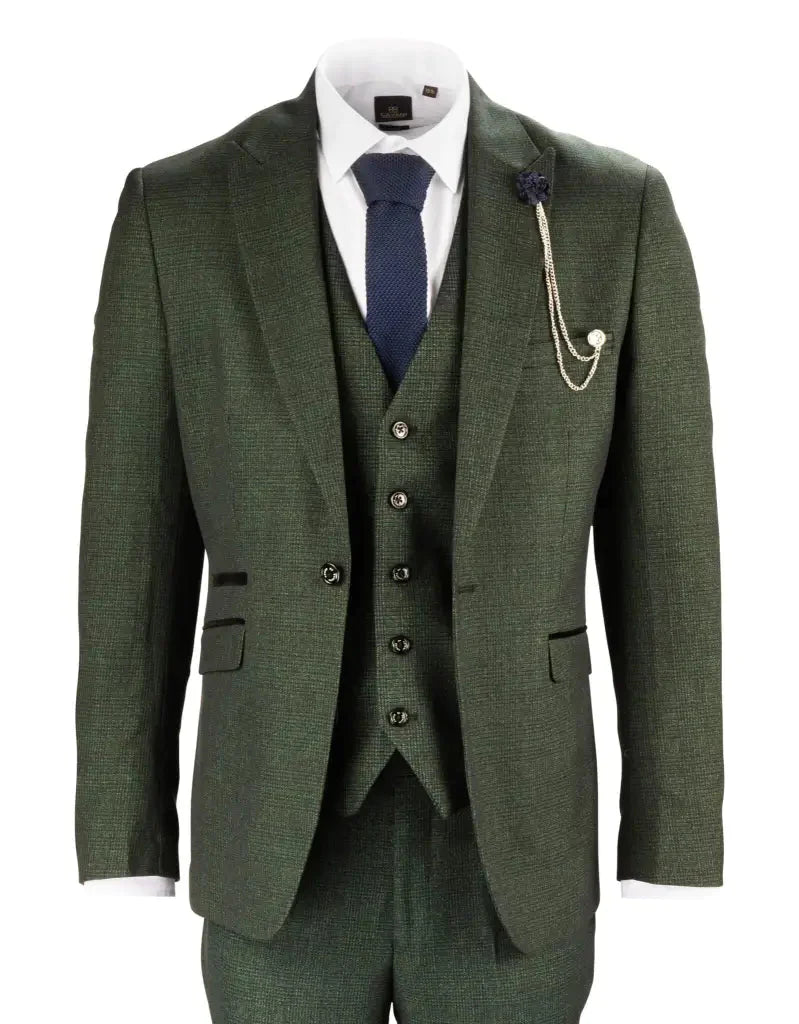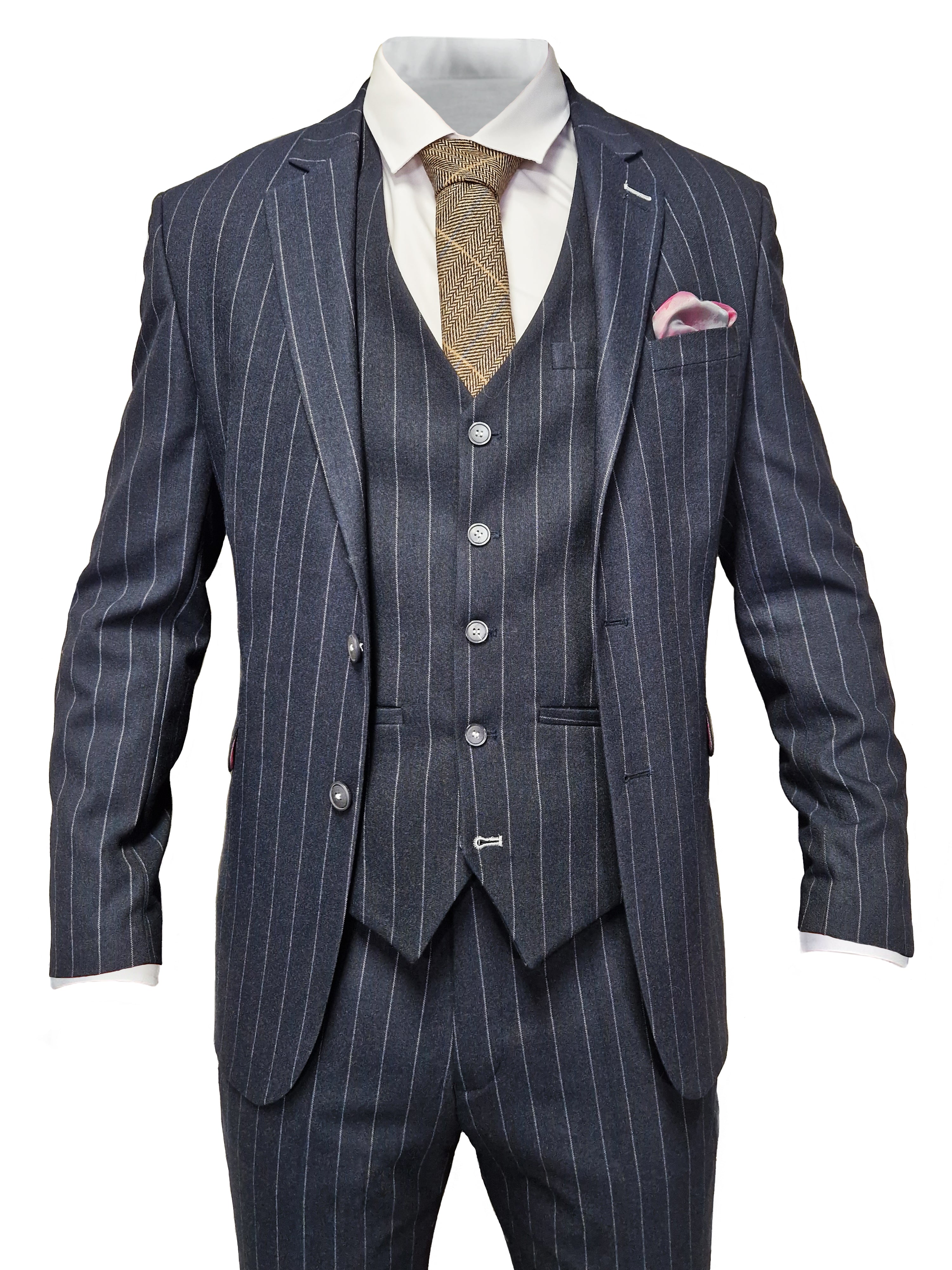
Men's Suits
Men's Suit
Our collection of men's suits is specially curated for the man in search of stylish and professional attire. Whether you have an important business meeting or attending a formal event, we have the perfect suit for every occasion. From classic black suits to modern navy blue and sky blue suits, The Garrison's collection of men's suits offers something for everyone. Shop now and feel confident and stylish in one of our men's suits.
What is a Men's Suit?
A men's suit is a garment made from the same fabric, and it comes in two-piece and three-piece variations. At a minimum, a men's suit consists of trousers and a jacket (two-piece suit). When the suit includes a jacket, vest, and trousers, it's referred to as a three-piece suit. At The Garrison, we have a wide range of three-piece suits suitable for both formal and informal occasions. We also have a dedicated category page for our finest wedding suits.
What to Consider When Buying a Men's Suit?
There are several aspects to consider when buying a men's suit. Below, we provide an overview to ensure you always look stylish and confident.
- The length of the jacket should be long enough, typically reaching just below the buttocks but not longer.
- The trousers should fit comfortably. Ensure they feel right when you're standing upright, and make sure you can move around comfortably throughout the day. Wrinkles around the hips often indicate that the trousers are too tight.
- Pay attention to how the suit fits at the shoulders. This area is typically not adjustable in most suits and should fit at the point where the shoulder ends and the arm begins. Sleeve length and trouser length can be easily adjusted by a tailor.
- Consider the color and patterns of your suit. It's important that the suit complements your skin tone. Generally, you play it safe by choosing a black, gray, or blue men's suit;
- Choose for a good fabric for your men's suit. Men's suits are often made from wool, cotton, linen, viscose, and/or polyester. Most of The Garrison's men's suits are a blend of wool, polyester, and viscose, making our suits extra comfortable;
How to Wear a Suit as a Man?
You've already received a comprehensive list of things to consider when buying a men's suit. However, it's equally important to know how to wear a suit and adhere to certain style etiquettes. Below are tips on how to wear a suit like a true man, the right way.
Make sure to "test" your suit first
You often buy a suit well in advance, especially a wedding suit or a suit for a gala. On the other hand, it may also be the case that you haven't worn a suit in a long time. Have you gained weight, lost weight, become broader, or has your shoulder size changed in the meantime? Then it's a good idea to "test" your suit shortly before the occasion. If necessary, you can still purchase a last-minute suit that fits nicely on your shoulders. Especially when you have a suit with shoulder pads, it's important to test your suit. It doesn't look good if the shoulder pads extend beyond your shoulders.
Make sure your tie is darker than your shirt
You want to create a contrast with your tie against the shirt. In many cases, you wear a light shirt under a men's suit. This could be a white or light blue shirt, for example. It looks nice if you choose a dark tie. Nowadays, patterns on ties are also becoming more common, especially for informal occasions.
Always open your jacket when you sit down
This is one of the most well-known style etiquettes. Nothing looks as awkward as a closed jacket when someone sits down. Unbutton the jacket or, if the occasion allows, take off the jacket. This also prevents the buttons from popping.
Never fasten both buttons of your jacket
When you stand up again, for example, to give an important speech, never fasten both buttons again. Only the top button should be fastened when wearing a men's suit.
Choose for a custom-fitted shirt
At The Garrison, you'll find various shirt models that pair perfectly with elegant and stylish jackets. It's important to know exactly how a shirt should fit in relation to the jacket. The jacket sleeves should be slightly shorter than the shirt sleeves, with the shirt extending about a centimeter below the jacket for a classic look.
Want to learn more about style etiquettes? Read our blog: The Art of Wearing a Suit. In it, you'll find everything you need to know about buying and wearing your men's suit.
What's the Difference Between a Suit, a Tuxedo, and a Smoking?
There is a difference between a men's suit and a men's suit. A suit is worn only for special occasions, such as a wedding. It can be made from various fabrics like wool, cotton, or polyester. A suit is mostly black, but there are also gray and blue suits. On the other hand, you can wear a men's suit to work or for informal occasions. When choosing a men's suit for everyday wear, many more colors and combinations are possible than with a suit.
Tuxedo
A tuxedo, also known as a tuxedo, is a specific type of suit often worn at galas and weddings. A tuxedo is typically made of black or dark blue fabric. The suit consists of a black jacket with satin lapels and matching black trousers. A tuxedo also includes black patent leather shoes, and you can choose either a bowtie or a black necktie with a bow.
Buying Men's Suits Online
Buying men's suits online has never been easier. With our sizing tool, you can easily determine the size that fits you best. Then, the suit is shipped with a form. This form contains a QR code that you can scan. When you scan it, the best tailors in your area will appear on your phone. Suppose you still need to make an adjustment. In that case, you can easily have it done by a tailor near you. All our suits have extra fabric that is finished on the inside. A tailor can easily lengthen or shorten your men's suit. If your suit is slightly tight at the waist, a tailor can also provide more room. In addition, the suit can be taken in if necessary. So, you can order a men's suit online and even have it custom-tailored in your area.
Free Shipping and Returns at The Garrison
At The Garrison, you can easily order all suits online with free shipping and returns. If you're not satisfied or the suit doesn't fit well, you can easily exchange it for another suit or choose for a refund. Your return will be processed according to your preference upon receipt. Are you looking for a handsome men's suit at a great price? Then you've come to the right place at The Garrison. We have a suit for every gentleman. While many suit shops only offer small sizes, we offer sizes from 1 year to 14 years old and from 34US to 52US. So, we have suits for both young and old, as well as for gentlemen with larger sizes. We also offer suits in various colors. If you're looking for a blue suit, that's no problem for us. We also have a fine selection of brown suits or gray suits. Discover all our men's suits quickly and shop today at The Garrison.
























































































































